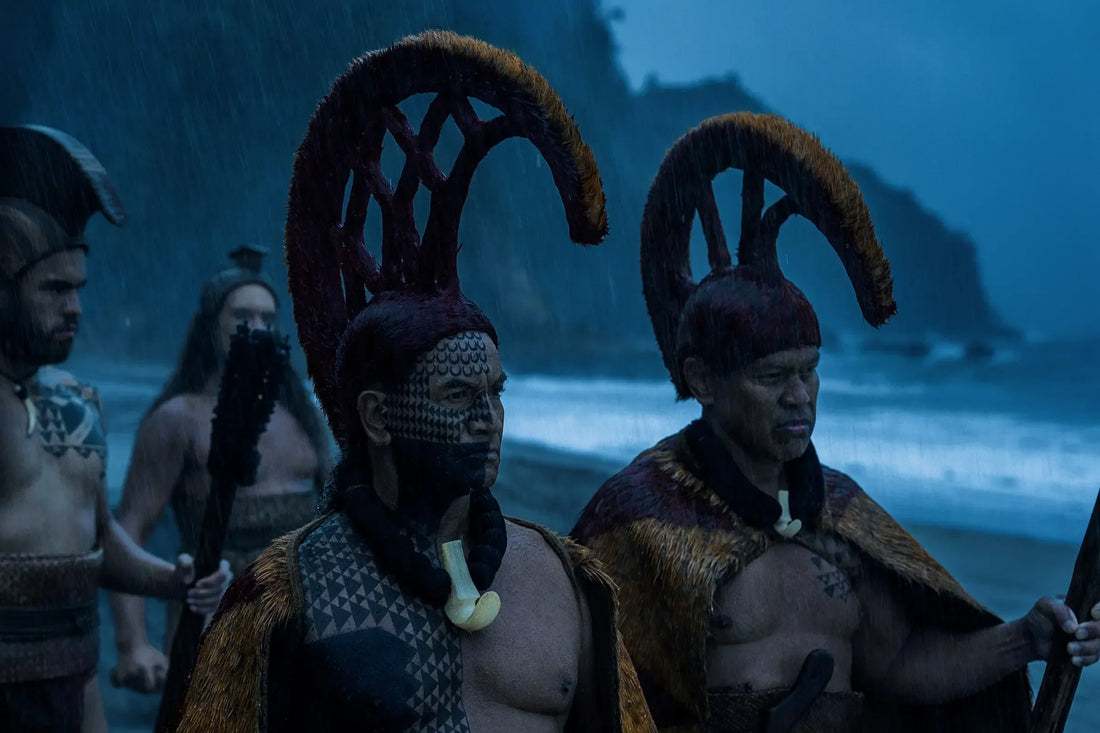
Traditional Hawaiian Weapons Featured in Jason Momoa's Chief of War
Share
Traditional Hawaiian Weapons of the King Kamehameha Era and Their Role in Chief of War
The Apple TV+ series Chief of War, co-created by Jason Momoa, has captivated global audiences by immersing them in the dramatic period of Hawaiian unification under King Kamehameha I. Beyond its sweeping battle scenes and cultural storytelling, one of the most compelling details in the series is its faithful recreation of traditional Hawaiian weapons.
These weapons—crafted from native woods, shark teeth, lava rock, and cordage—were not just tools of war. They embodied the resourcefulness, artistry, and ingenuity of Native Hawaiians in an era before firearms became widespread. They also reflect the high stakes of interisland conflict in the late 18th century, when chiefs fought for land, prestige, and power.
Here’s a closer look at the most iconic Hawaiian weapons of the Kamehameha era, their history, and how they are showcased in Chief of War.
Hawaiian Warfare Before Western Contact
Prior to European arrival in the late 18th century, Hawaiian warfare was conducted with handcrafted, close-combat weapons. Hawaiians did not have metal forging technologies, so they relied on natural materials:
- Hard native woods like kauila and koa for clubs and spears.
- Shark teeth for cutting edges.
- Volcanic basalt and obsidian for blades.
- ʻOlona cordage for binding, prized for its durability.
Hawaiian warriors, or koa, trained extensively in martial traditions, and battles were often fought in open fields or along shorelines. By Kamehameha’s time, Western firearms and cannons had entered the battlefield, but traditional weapons remained essential in close combat.
The Leiomano – Shark-Tooth Weapon
One of the most fearsome and iconic Hawaiian weapons is the leiomano, a club, paddle, or dagger embedded with rows of razor-sharp shark teeth.
Features:
- Constructed from hardwood and set with tiger shark or great white shark teeth.
- Could be shaped like a small paddle, club, or hand weapon.
- Inflicted devastating slashing wounds.
Cultural Significance:
The leiomano symbolized courage and connection to the sea, drawing from the mana (spiritual power) of sharks, revered as protectors and ancestral guardians (ʻaumākua).
In Chief of War, warriors are seen carrying leiomano in battle, a striking reminder of how Hawaiians fused artistry and intimidation in their weaponry.
Spears – Pololū and Ihe
Spears were the primary battlefield weapons of Hawaiian warriors.
Pololū – Long Spear
- Up to 12–20 feet in length.
- Used for thrusting and keeping enemies at a distance.
- Could be hurled with great force or used to pin shields.
Ihe – Short Spear
- Ranged from 6–8 feet long.
- Ideal for close combat thrusting and throwing.
- Warriors often carried several ihe into battle.
Spears were carefully crafted from hardwood and sometimes tipped with sharpened bone or stone. In Kamehameha’s campaigns, they remained crucial for both massed formations and one-on-one duels.
Clubs – Pāhoa Kūʻi ʻAi and ʻŌʻō
Hawaiian clubs came in many shapes, from heavy maces to dagger-like striking tools.
- Pāhoa Kūʻi ʻAi: A dagger or short club used for stabbing.
- ʻŌʻō: A digging stick sometimes adapted into a weapon.
- Nīoi clubs: Knot-shaped striking clubs designed to break bones.
These close-combat weapons were valued for their raw impact and durability. Made of dense kauila wood, they could crush skulls or disable enemies quickly.
In Chief of War, such clubs appear in fast-paced, close-quarters fighting sequences, demonstrating how Hawaiian warriors engaged after spear volleys.

Pāhoa – The Hawaiian Dagger
The pāhoa was a wooden or stone dagger, sometimes resembling a short spear. Warriors carried them as sidearms, ready for close-quarter grappling and finishing strikes.
Daggers could be single- or double-edged, with edges honed from basalt or obsidian. They often appear in the hands of chiefs and skilled fighters in reenactments and historical drama like Chief of War.
Slings (Maʻa)
Though less visually dramatic, slings (maʻa) were a strategic weapon in Hawaiian warfare. Made from twisted fiber cord, slings could hurl stones with deadly force, reaching enemies before hand-to-hand combat began.
Sling stones (* pōhaku kaua*) were carefully shaped and sized, sometimes collected for battle in advance. In Chief of War, sling-wielding warriors emphasize the tactical diversity of Hawaiian forces.
Defensive Gear – Shields and Armor
Unlike many other cultures, Hawaiians did not traditionally use heavy shields or metal armor. Instead:
-
Woven mats and helmets (mahiole) provided some protection.
-
Chiefs and warriors relied on speed, agility, and spiritual protection (kapu and prayers) over heavy defenses.
The mahiole helmet and feather cloaks (ahuʻula) served both protective and symbolic roles, reserved for aliʻi (chiefs). These appear prominently in Chief of War, visually distinguishing leaders on the battlefield.
Firearms and Cannons in the Kamehameha Era
By the late 18th century, Western ships brought muskets, pistols, and cannons to Hawaiʻi. King Kamehameha I was among the first aliʻi to strategically adopt these weapons, acquiring them through trade with Europeans and Americans.
The famous Battle of Nuʻuanu (1795), which secured Oʻahu under Kamehameha’s rule, saw a mix of muskets, cannons, and traditional arms. In Chief of War, this blend of weapons highlights the transitional period of Hawaiian warfare, where koa warriors still fought with leiomano and spears alongside cannon fire.
The Cultural Importance of Weapons
Hawaiian weapons were more than military tools; they carried spiritual and cultural significance.
- Crafted with prayers and rituals, they embodied mana (spiritual power).
- Certain weapons were passed down as heirlooms, linking families to warrior ancestors.
- The artistry of weapon-making reflected the deep respect Hawaiians had for their environment, using resources sustainably and skillfully.
In Chief of War, the emphasis on these weapons underscores their role as symbols of identity and resilience, not just instruments of violence.
Hawaiian Weapons as Art and Legacy
Today, traditional Hawaiian weapons are displayed in museums like the Bishop Museum in Honolulu, preserved in private collections, and recreated by cultural practitioners who keep the art of weapon-making alive.
They are also celebrated in hula kahiko (ancient hula), reenactments, and educational programs, where they help teach history, values, and craftsmanship to new generations.
Final Thoughts
The weapons of King Kamehameha’s era—from shark-tooth clubs to hardwood spears and basalt daggers—represent both the artistry and ferocity of Hawaiian warriors.
By showcasing these arms in Chief of War, Jason Momoa’s series not only dramatizes Hawaiʻi’s history but also helps global audiences appreciate the ingenuity and cultural depth behind Hawaiian warfare.
These weapons remind us that Hawaiians, though isolated in the Pacific, developed a martial culture uniquely adapted to their environment—one that balanced warfare with spirituality, craftsmanship, and identity.
As Hawaiʻi continues to share its stories on the global stage, the image of koa warriors wielding leiomano and spears will stand as a testament to the strength, resilience, and cultural pride of the Hawaiian people.
